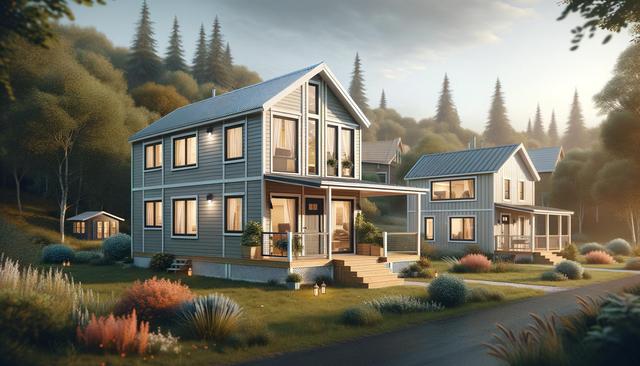Why Modular Homes Are a Smart Choice for Seniors
Modular homes have increasingly become a favored option for seniors seeking comfortable, adaptable, and efficient living solutions. These homes are constructed in sections at a factory and then assembled on-site, allowing for faster building times and often lower costs compared to traditional homes. For seniors, this means less waiting and reduced hassle, with the added benefit of structures that can be tailored to meet specific mobility or accessibility needs.
One of the major advantages of modular homes for seniors is their flexibility in design. Whether opting for a compact 1-room layout or a more spacious 4-room configuration, modular homes can be designed to prioritize safety, ease of movement, and energy efficiency. Features like wider doorways, walk-in showers, and single-floor layouts are commonly incorporated to support aging in place.
Other benefits include:
- Quick construction timelines
- Lower maintenance requirements
- Customizable interior and exterior finishes
- Energy-efficient materials and appliances
These elements make modular homes not just an affordable alternative but also a long-term solution that evolves with the resident’s needs.
Room-by-Room Efficiency: Living Spaces That Work
Creating a living space that supports daily routines and comfort is essential, particularly for seniors. Modular homes offer well-thought-out floor plans where each room is designed for functionality and flow. Starting with the living room, open layouts allow for easy navigation and social interaction. Natural lighting is emphasized to enhance mood and reduce reliance on artificial light.
In the kitchen, layouts are often compact yet efficient, with lower countertops and easy-reach cabinets. This design approach minimizes strain and maximizes usability. For those who enjoy cooking or baking, additional options like pull-out pantries or under-counter appliances can be included. Dining areas, whether part of the kitchen or separate, are designed to accommodate everyday meals or small gatherings without feeling cramped.
Bedrooms are another area where comfort meets practicality. Modular home designs often include:
- Ample closet space
- Noise-reducing insulation
- Large windows for ventilation
- Optional en-suite bathrooms
Each space contributes to a cohesive environment that supports independent living while remaining adaptable to future needs.
Accessibility and Safety Features for Peace of Mind
For seniors, safety and accessibility are not optional—they’re essential. Modular homes can be fitted with features that prioritize these aspects without compromising on style or function. Thoughtful design elements can help reduce the risk of falls and make everyday tasks more manageable.
Common accessibility features include:
- Step-free entrances
- Non-slip flooring throughout the home
- Lever-style door handles
- Walk-in tubs and roll-in showers
Additionally, many modular home builders offer smart home technology integration, which can include lighting systems with motion sensors, emergency call buttons, and even voice-activated controls. These features collectively enhance the livability of the home and reduce dependency on external support.
For seniors with mobility aids such as walkers or wheelchairs, modular homes can be customized with wider hallways and turning radii, ensuring that the entire home remains accessible and welcoming.
Customizable Layouts to Match Individual Needs
One of the strongest appeals of modular homes is the ability to personalize layouts to suit individual lifestyles. Whether someone prefers a minimalist 1-room design or a home with multiple spaces for hobbies, guests, or caregivers, modular homes offer a range of configurations. Seniors who live independently may choose a compact layout that is easy to manage, while those who anticipate needing live-in support might opt for an extra room dedicated to a caregiver or healthcare professional.
Modular homes can also be designed with future adaptability in mind. For example, a second bedroom could be easily converted into a home office, a hobby room, or a guest room. This flexibility ensures that the home remains functional as needs change over time. Some seniors may even choose dual-purpose rooms, such as a dining area that doubles as a workspace or a living room that includes exercise equipment.
This level of customization empowers seniors to create a home that truly reflects their lifestyle, preferences, and long-term plans—without the limitations often found in traditional housing options.
Sustainable and Cost-Effective Living for the Long Term
Affordability and sustainability are key concerns for many seniors, particularly those on fixed incomes. Modular homes address both of these concerns by offering energy-efficient construction and low ongoing maintenance. Many designs use sustainable building materials and advanced insulation techniques to reduce heating and cooling costs, which can make a substantial difference over time.
Solar panel compatibility, energy-efficient windows, and smart thermostats are just a few options that can be incorporated into modular designs. These features not only lower utility bills but also contribute to a more eco-conscious lifestyle. Additionally, because modular homes are built in controlled factory environments, there is typically less waste and better quality control compared to traditional onsite construction.
From a financial perspective, modular homes can also be a more manageable investment. With various financing options available and the ability to choose layouts and finishes that fit a specific budget, seniors can make informed decisions that align with their financial goals. The reduced need for costly renovations or repairs further adds to the appeal, making modular homes a practical option for long-term living.
Conclusion: A Modern Housing Solution for Senior Living
Modular homes present a thoughtful and adaptable solution for seniors who value independence, safety, and efficiency. With the ability to customize layouts and integrate essential accessibility features, these homes support a wide range of lifestyles and future needs. Whether looking for a compact space or a multi-room layout for enhanced flexibility, modular homes offer a compelling blend of comfort and practicality. For seniors seeking a living arrangement that evolves with them, modular homes stand out as a well-regarded option in modern housing.
